Back to Journals » Patient Preference and Adherence » Volume 16
Parental Acceptance of Human Papillomavirus (HPV) Vaccination in Districts with High Prevalence of Cervical Cancer in West Java, Indonesia
Authors Frianto D, Setiawan D, Diantini A , Suwantika AA
Received 12 April 2022
Accepted for publication 15 September 2022
Published 29 September 2022 Volume 2022:16 Pages 2709—2720
DOI https://doi.org/10.2147/PPA.S365901
Checked for plagiarism Yes
Review by Single anonymous peer review
Peer reviewer comments 3
Editor who approved publication: Dr Johnny Chen
Dedy Frianto,1,2 Didik Setiawan,3 Ajeng Diantini,1,4 Auliya A Suwantika1,4
1Department of Pharmacology and Clinical Pharmacy, Faculty of Pharmacy, Universitas Padjadjaran, Bandung, Indonesia; 2Faculty of Pharmacy, Universitas Buana Perjuangan, Karawang, Indonesia; 3Faculty of Pharmacy, Universitas Muhammadiyah Purwokerto, Purwokerto, Indonesia; 4Center of Excellence in Higher Education for Pharmaceutical Care Innovation, Universitas Padjadjaran, Bandung, Indonesia
Correspondence: Auliya A Suwantika, Department of Pharmacology and Clinical Pharmacy, Faculty of Pharmacy, Universitas Padjadjaran, Bandung, Indonesia, Email [email protected]
Background: Cervical cancer is the second-highest cause of death in women with cancer, which is mostly caused by human papillomavirus (HPV) infection, specifically HPV 16 and 18. Next to Pap smear and visual inspection with acetic acid, HPV vaccination is highly recommended to support preventive measures.
Objective: This study aimed to determine parental acceptance of HPV vaccination in districts with high prevalence of cervical cancer and different levels of household income in West Java, Indonesia by taking several factors into account.
Methods: A questionnaire was delivered to 286 parents who met the major inclusion criteria of having daughters at 5th or 6th grade of elementary schools in three selected districts: Bandung, Purwakarta and Karawang. In particular, logistic regression analysis was applied to investigate the correlation of acceptance towards HPV vaccination with sociodemographic factors.
Results: Respondents in Bandung, Purwakarta and Karawang were willing to pay for HPV vaccine at a price range of US$ 1.38– 20.69, US$ 0.07– 34.48, and US$ 1.38– 6.90, respectively. In addition, respondents’ spouse was the key person influencing their decision to vaccinate their children.
Conclusion: Education level and health beliefs toward cervical cancer have significant correlation (p-value < 0.05) with acceptance towards HPV vaccination.
Keywords: HPV vaccination, knowledge, health belief, attitude, willingness to pay
Introduction
Cervical cancer is one of the diseases with high incidence and economic burden, specifically in low- and middle-income countries, with 527,624 reported new cases.1 The WHO highlighted the incidence rate of cervical cancer at 13.1/1,000,000 women, which placed cervical cancer in the 4th rank among other cancers.2 In 2020, GLOBOCAN mentioned a high prevalence rate of cervical cancer in South East Asia at 51.27 per 100,000 population.3 In Indonesia, the incidence number of cervical cancer was reported to be 36,633 cases with the number of fatal cases at 21,003.4 The prevalence of HPV infection among Indonesian women was estimated to be 5.2%.5 As the most populous province in Indonesia, the annual number of new cases related to cervical cancer in West Java is more than 200 cases.6
Next to Pap smear and visual inspection with acetic acid, HPV vaccination is highly recommended to support preventive measures.7 Despite the increasing incidence of cervical cancer in Indonesia, HPV vaccine has not yet been included in the national immunization program. Currently, HPV vaccine in Indonesia is available in the private market at US$ 52–90 per dose injection.5 The government of Indonesia is planning to add HPV vaccination into the national immunization program.5 Following the success of a national HPV demonstration program in 2017, the plan to roll out free HPV vaccination will be targeted for girls enrolled in 5th and 6th grades of elementary school.5
Learning from the experience of new vaccine introduction in Indonesia, factors associated with public acceptance are critical on the successful implementation of new vaccination, such as issues related to safety and halal status of vaccines.8–11 This study aimed to determine parental acceptance of HPV vaccination in districts with high prevalence of cervical cancer and different levels of household income in West Java, Indonesia by taking several factors into account (eg, sociodemographic; knowledge of HPV, HPV vaccination and cervical cancer; health beliefs toward cervical cancer; and attitudes towards vaccination).
Methods
Study Design
This study was approved by the Ethics Committee of Universitas Padjadjaran, Indonesia (approval number: 106/UN6.KEP/EC/2019) and conducted in accordance with the Declaration of Helsinki. A cross-sectional design was applied by taking place at one point in time giving a snapshot of the respondents’ responses.
Participants
A valid and reliable questionnaire in the Indonesian language from a previous study was delivered to 286 parents who met the major inclusion criteria of having daughters at 5th or 6th grade of elementary schools in Bandung, Purwakarta and Karawang, and had willingness to fill in the questionnaire within six sections.9
Survey and Questionnaire
In the first section, respondents were requested to provide their sociodemographic information and answer several general questions. In the second section, respondents were given eight questions to determine their level of knowledge in a maximal score of 8 by considering each question would give 1 and 0 point for the correct and wrong answer, respectively. In the third section, respondents were given six questions to find out their general attitude towards vaccines where they can strongly disagree (0), disagree (1), somewhat disagree (2), somewhat agree (3), agree (4) or strongly agree (5) in each question. We applied the traditional way to report on a Likert scale by summing the values of each selected option and creating a score for each respondent with a maximal score of 30 for six questions. In the fourth section, respondents were given four questions to find out their health beliefs about cervical cancer with a maximal score of 9. For the first question, participants could receive 0, 1, 2, 3 or 4 points. For the second and third questions, participants could receive 0 or 1 point. For the fourth question, participants could receive 0, 1, 2, or 3 points. In the last two sections, respondents were requested to answer questions about acceptance towards HPV vaccine and factors that might hinder the vaccination program, respectively.
Statistical Analysis
Descriptive and logistic regression analyses were applied to analyse the results of questionnaire. In particular, logistic regression analysis was applied to investigate the correlation between acceptance towards HPV vaccination with sociodemographic factors, knowledge of HPV, HPV vaccination and cervical cancer; and health beliefs toward cervical cancer. Statistical significance value was considered at p-value <0.05. Data were analyzed statistically by using SPSS.
Result
General Information
The majority of respondents in all districts were Moslem. Most respondents in Bandung (59%), Purwakarta (35%) and Karawang (79%) graduated from universities, high and elementary schools, respectively. Most respondents had no relatives with cancer, including cervical cancer, and had no relatives who experienced cervical cancer screening. Regarding vaccination, the majority of respondents confirmed that their children have been fully vaccinated for routine immunization programs and they had no experience with side effects of vaccination. The majority of respondents got the information about HPV, cervical cancer and HPV vaccination from television, radio and internet. Approximately 55%, 28%, and 20% respondents in Bandung, Purwakarta and Karawang, respectively, had willingness to vaccinate their children with HPV vaccine (see Table 1).
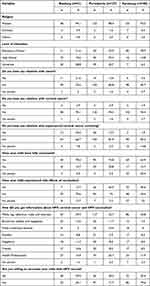 |
Table 1 General Information of Respondents |
Knowledge About HPV, Vaccination and Cervical Cancer
From eight true/false statements, the majority of these statements (87.5%) could be understood correctly by the most of respondents (see Table 2). The only statement that most of the respondents could not understand correctly is the third statement. They did not know that the number of HPV infection in Bandung, Purwakarta and Karawang was considered to be very rare with an annual number of 2–7 new cases.12
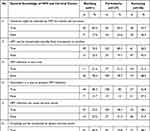 |
Table 2 Respondents’ Knowledge About HPV, Vaccination and Cervical Cancer |
Attitude Towards Vaccination and Health Beliefs Regarding Cervical Cancer
Regarding respondents’ general attitude towards vaccination, the majority of respondents strongly agreed that preventive action is better than treatment (statement 1) and vaccination is good for children’s health (statement 3). Most of them also agreed that vaccination is effective to prevent disease (statement 2). The majority of respondents in Bandung somewhat agreed that feeling worried about vaccine’s side effects (statement 4) and most of respondents in Purwakarta and Karawang agreed. In particular, the majority of respondents disagreed that vaccines are administered to prevent very severe disease (statement 5). Regarding the last statement, most of respondents in Bandung agreed that vaccines are administered to prevent sexually transmitted diseases and most of respondents in Purwakarta and Karawang strongly agreed (see Table 3). In the context of respondents’ health beliefs regarding cervical cancer, most respondents agreed that cervical cancer is a dangerous disease and can cause physical problems and stress. Most of respondents also felt very worried if their children had cervical cancer (see Table 4).
 |
Table 3 General Attitude Towards Vaccination |
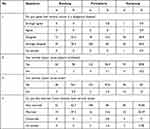 |
Table 4 Health Beliefs Regarding Cervical Cancer |
Decision-Making Process
Table 5 illustrates information about respondents’ decision-making process related to HPV vaccination. Respondents were willing to vaccinate their children with HPV vaccine since HPV vaccine is the best way to protect girls from cervical cancer. On the other hand, they were not willing to vaccinate their children with HPV vaccine because of the price of HPV vaccine. Additionally, respondents’ spouse was the key person influencing their decision to vaccinate their children. The majority of respondents confirmed that religion did not give impact on their decision-making process. Most of them were able and willing to pay for HPV vaccine. Respondents in Bandung, Purwakarta and Karawang were willing to pay for HPV vaccine at a price range of US$ 1.38–20.69, US$ 0.07–34.48, and US$ 1.38–6.90, respectively. The majority of respondents confirmed that HPV vaccine is safe and effective, so it is necessary for the government to include HPV vaccine into routine immunization program. In addition, they also confirmed that government should be responsible for paying HPV vaccination and their preferable places for HPV vaccination are hospitals and public healthcare centers.
 | 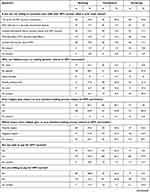 | 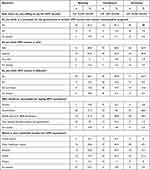 |
Table 5 Respondent’s Decision-Making Process Related to HPV Vaccination |
Logistic Regression Analysis
Logistic regression analysis was applied to investigate the correlation between acceptance towards HPV vaccination with religion, education level, income, knowledge of HPV, HPV vaccination and cervical cancer, and health beliefs toward cervical cancer. Applying two levels of acceptance towards HPV vaccination (in favor of and against HPV vaccination), the results showed that education level and health beliefs toward cervical cancer have significant correlation (p-value <0.05) with acceptance towards HPV vaccination (see Table 6).
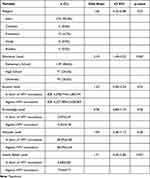 |
Table 6 Logistic Regression Analysis |
Discussion
From 286 respondents who met the major inclusion criteria, most of respondents in Bandung, Purwakarta and Karawang graduated from universities, high and elementary schools, respectively. This proportion is linear with the education level of total population in these selected districts, as reported by Statistics of West Java in 2017–2019.13 Most respondents had no relatives who experienced cervical cancer screening. Up to now, cervical cancer screening remains uncommon in Indonesia and the refusal rate is relatively high. A previous study reported that almost 50% of women in East Java, Indonesia refused to be screened for cervical cancer.14 In addition, the majority of respondents confirmed that their children have been fully vaccinated for routine immunization programs. This finding is linear with the result of Basic Health Research in 2018, which confirmed the coverage of complete basic immunization for children in Indonesia at 58%.15 Most respondents also confirmed that their children have not experienced side effects of vaccination, which is similar with the results of a previous study in Central Java, Indonesia 16
Despite the majority of statements related to the knowledge about HPV, vaccination and cervical cancer could be understood correctly by the most of respondents, most of respondents did not know the fact that the number of HPV infection in Bandung, Purwakarta and Karawang is considered to be relatively low with an annual number of 2–7 new cases,12 compared with the prevalence of HPV infection among Indonesian women at 5.2% and total HPV infection in West Java at 15,635 cases.5,17 Another previous study also reported the low awareness level of Indonesian women regarding cervical cancer issues in social media, including the annual incidence of cervical cancer.18 Furthermore, the majority of respondents strongly agreed that preventive action is better than treatment and vaccination is good for children’s health. These findings strengthen the results of two other previous studies. Using the COVID-19 pandemic as a reference case, more Indonesian people realized that preventing diseases are more important that treating diseases.19 A previous study that focused in South East Asia countries also highlighted that knowledge level about HPV vaccine and free of charge for HPV vaccine are two critical factors in parental acceptance of HPV vaccine in this region.20 Additionally, most of respondents in this study strongly agreed and agreed that vaccines are administered to prevent sexually transmitted diseases. This finding is linear with the result of a previous study in Riau, Indonesia, which confirmed that sexual transmission was the major factor affecting the incidence of cervical cancer in Indonesia.21
With respect to health beliefs regarding cervical cancer, most of respondents agreed that cervical cancer is a dangerous disease and can cause physical problems and stress. These results reconfirmed the finding of a previous study in Bali, which highlighted that cervical cancer is one of ten infectious and non-infectious diseases impacting the highest epidemiology and economic burden.22 In particular, respondents were willing to vaccinate their children with HPV vaccine since HPV vaccine is the best way to protect girls from cervical cancer. On the other hand, they were not willing to vaccinate their children with HPV vaccine because of the price of HPV vaccine. These findings strengthen the results of previous studies in Indonesia. Two previous cost-effectiveness studies of HPV vaccination in Indonesia concluded that nationwide vaccination was considered to be cost-effective or even cost-saving.7,23 Another study by Wijayanti et al also concluded that free of charge for HPV vaccine would increase level of parental acceptance in Indonesia.20 Moreover, this study found that respondents’ spouse was the key person influencing their decision to vaccinate their children, which is linear with a previous study in Mali that identified respondents’ husbands as primary decisions makers.24 The majority of respondents in this study also confirmed that religion did not give impact on their decision-making process, which is similar with a previous study that confirmed no correlation between religiosity and vaccination status.25
Even though this study has several major findings, it also has several limitations. The major limitation is related to geographical setting. Given limited resources, this study was focused in Bandung, Purwakarta and Karawang, which aimed to investigate the parental willingness to pay for HPV vaccine in three districts with different levels of household income. This study found that respondents in Bandung, Purwakarta and Karawang were willing to pay for HPV vaccine at a price range of US$ 1.38–20.69, US$ 0.07–34.48, and US$ 1.38–6.90, respectively. The result in Purwakarta confirmed a very huge range of willingness to pay for HPV vaccine at US$ 0.07–34.48. This situation might be caused by the highest income inequality between three selected districts was found in Purwakarta, as reported in Gini coefficient data.26 Nevertheless, the majority of respondents confirmed that government should be responsible for paying HPV vaccination. Another limitation is the potential missing factors in the logistic regression that could have confounded the results.
In particular, this study concluded that education level and health beliefs toward cervical cancer have significant correlation (p-value <0.05) with acceptance towards HPV vaccination. These findings are similar with the results of two previous studies. A study in Korea highlighted multiple dimensions of health beliefs showed differing impacts on vaccine acceptance.27 Several previous studies also confirmed that parents’ education was associated with the acceptance of HPV vaccine in several countries.28–30
To our knowledge, this is the first study to investigate parental acceptance of HPV vaccination in districts with high prevalence of cervical cancer and different levels of household income in Indonesia. Our findings confirmed that education level and health beliefs toward cervical cancer have significant correlation with acceptance towards HPV vaccination. Dealing with the cost barrier and improving awareness about HPV might improve parental acceptance and vaccination rate.31 Hopefully, this study can assist the stakeholder in increasing parental acceptance towards HPV vaccination in Indonesia, specifically in West Java as the most populous province in Indonesia with high prevalence of cervical cancer, by taking these two critical factors into account.
Conclusion
Respondents in Bandung, Purwakarta and Karawang were willing to pay for HPV vaccine at a price range of US$ 1.38–20.69, US$ 0.07–34.48, and US$ 1.38–6.90, respectively. In addition, respondents’ spouse was the key person influencing their decision to vaccinate their children. To conclude, education level and health beliefs toward cervical cancer have significant correlation (p-value <0.05) with acceptance towards HPV vaccination. Several comprehensive approaches can be applied to increase parental acceptance towards HPV vaccination in Indonesia by taking education level and health beliefs.
Acknowledgment
This research was funded by Universitas Buana Perjuangan and Universitas Padjadjaran (Grant number: 1959/UN6.3.1/PT.00/2021) through DF and AD, respectively.
Disclosure
The authors report no conflicts of interest in this work.
References
1. Shrestha AD, Neupane D, Vedsted P, Kallestrup P. Cervical cancer prevalence, incidence and mortality in low and middle income countries: a systematic review. Asian Pac J Ca`cer Prev. 2018;19(2):319–324. doi:10.22034/APJCP.2018.19.2.319
2. Arbyn M, Weiderpass E, Bruni L, et al. Estimates of incidence and mortality of cervical cancer in 2018: a worldwide analysis. Lancet Glob Health. 2020;8(2):e191–e203. doi:10.1016/S2214-109X(19)30482-6
3. Global Cancer Observatory. South-Eastern Asia: incidence, mortality and prevalence by cancer site. Available from: https://gco.iarc.fr/today/data/factsheets/populations/920-south-eastern-asia-fact-sheets.pdf.
4. Global Cancer Observatory. Indonesia: incidence, mortality and prevalence by cancer site. Available from: https://gco.iarc.fr/today/data/factsheets/populations/360-indonesia-fact-sheets.pdf.
5. Winarto H, Habiburrahman M, Dorothea M, et al. Knowledge, attitudes, and practices among Indonesian urban communities regarding HPV infection, cervical cancer, and HPV vaccination. PLoS One. 2022;17(5):e0266139. doi:10.1371/journal.pone.0266139
6. Province of West Java. Early detection to prevent cancer. Available from: https://jabarprov.go.id/index.php/news/36363/2020/02/04/Deteksi-Dini-Demi-Cegah-Kanker.
7. Setiawan D, Dolk FC, Suwantika AA, Westra TA, WIlschut JC, Postma MJ. Cost-utility analysis of human papillomavirus vaccination and cervical screening on cervical cancer patient in Indonesia. Value Health Reg Issues. 2016;9:84–92. doi:10.1016/j.vhri.2015.10.010
8. Fonjungo F, Banerjee D, Abdulah R, et al. Sustainable financing for new vaccines in Indonesia: challenges and strategies. Sustainability. 2020;12(21):9265. doi:10.3390/su12219265
9. Jaspers L, Budiningsih S, Wolterbeek R, Henderson FC, Peters AA. Parental acceptance of human papillomavirus (HPV) vaccination in Indonesia: a cross-sectional study. Vaccine. 2011;29(44):7785–7793. doi:10.1016/j.vaccine.2011.07.107
10. Lou J, Kc S, Toh KY, et al. Real-world data for health technology assessment for reimbursement decisions in Asia: current landscape and a way forward. Int J Technol Assess Health Care. 2020;36(5):474–480. doi:10.1017/S0266462320000628
11. Suwantika AA, Postma MJ. Expanding access to non-traditional vaccines: a perspective from Indonesia. Expert Rev Vaccines. 2014;13(12):1419–1421. doi:10.1586/14760584.2014.944165
12. Open Data of West Java. Suspected women with cervical cancer in West Java. Available from: https://opendata.jabarprov.go.id/id/dataset/jumlah-perempuan-usia-30-50-tahun-yang-dicurigai-kanker-leher-rahim-dan-payudara-berdasarkan-kabupatenkota-di-jawa-barat.
13. Statistics of West Java. Number of population in West Java. Available from: http://jabar.bps.go.id/subyek/jumlah-penduduk-kabupatenkota-di-jawa-barat-2004-2012.
14. Anwar SL, Tampubolon G, Van Hemelrijck M, Hutajulu SH, Watkins J, Wulaningsih W; PILAR Research Network. Determinants of cancer screening awareness and participation among Indonesian women. BMC Cancer. 2018;18(1):208. doi:10.1186/s12885-018-4125-z
15. Ministry of Health, Republic of Indonesia. Basic Health Research 2018. Available from: https://kesmas.kemkes.go.id/assets/upload/dir_519d41d8cd98f00/files/Hasil-riskesdas-2018_1274.pdf.
16. Jurnal Ilmiah Farmasi. An overview of MR vaccine’ side effects in children under five years old in Bulakparen. Available from: http://eprints.poltektegal.ac.id/135/2/jurnal%20kti%20Devi%20Ratnasari.pdf.
17. Larasati L, Afiyanti Y, Rahmah H, Milanti A. Women’s knowledge, beliefs, and behaviors toward the prevention of human papillomavirus transmission. Enfermería Clínica. 2018;28(Supplement 1):191–194. doi:10.1016/S1130-8621(18)30065-2
18. Rachmawati RP, Herieningsih S. Correlation between social media exposure and perception of vulnerability with adolescent girls’ interest in cervical cancer screening in Semarang City. Interaksi Online. 2018;6(2):134–143.
19. Zendrato W. Prevention is better than treatment: a campaign during the COVID-19 pandemic. J Educ Dev. 2020;8(2):242.
20. Wijayanti KE, Schütze H, MacPhail C, Braunack-Mayer A. Parents’ knowledge, beliefs, acceptance and uptake of the HPV vaccine in members of The Association of Southeast Asian Nations (ASEAN): a systematic review of quantitative and qualitative studies. Vaccine. 2021;39(17):2335–2343. doi:10.1016/j.vaccine.2021.03.049
21. Lismaniar D, Wulan WS, Wardani SW, Purba CVG, Abidin AR. Risk factors associated with cervical cancer incidence at Arifin Achmad Regional Hospital, Riau Province in 2020. Public Health Media. 2021;1:1023–1042.
22. Simarmata OS, Lolong DB, Pangaribuan L, Sulistiyowati N, Sulistiowati E. Pattern of cause of death in Gianyar District 2010–2012. Bulletin Health Res. 2018;46(2):77–86.
23. Setiawan D, Andrijono Hadinegoro SR, Meyta H, et al. Cervical cancer prevention in Indonesia: an updated clinical impact, cost-effectiveness and budget impact analysis. PLoS One. 2020;15(3):e0230359. doi:10.1371/journal.pone.0230359
24. De Groot AS, Tounkara K, Rochas M, et al. Knowledge, attitudes, practices and willingness to vaccinate in preparation for the introduction of HPV vaccines in Bamako, Mali. PLoS One. 2017;12(2):e0171631. doi:10.1371/journal.pone.0171631
25. Reynolds D. Religiosity and parental acceptance of human papillomavirus (HPV) vaccine in 9–18 year-old girls. J Christ Nurs. 2014;31(3):172–177. doi:10.1097/CNJ.0000000000000076
26. Statistics of West Java. Gini Ratio in 2019–2021. Available from: https://jabar.bps.go.id/indicator/23/41/1/gini-rasio-kabupaten-kota.html.
27. Kim J. The relationship of health beliefs with information sources and HPV vaccine acceptance among young adults in Korea. Int J Environ Res Public Health. 2018;15(4):673. doi:10.3390/ijerph15040673
28. Gomes JM, Silva BM, Santos EFS, et al. Human Papillomavirus (HPV) and the quadrivalent HPV Vaccine among Brazilian adolescents and parents: factors associated with and divergences in knowledge and acceptance. PLoS One. 2020;15(11):e0241674. doi:10.1371/journal.pone.0241674
29. Rabiu KA, Alausa TG, Akinlusi FM, Davies NO, Shittu KA, Akinola OI. Parental acceptance of human papillomavirus vaccination for adolescent girls in Lagos, Nigeria. J Family Med Prim Care. 2020;9(6):2950–2957. doi:10.4103/jfmpc.jfmpc_102_20
30. Sitaresmi MN, Rozanti NM, Simangunsong LB, Wahab A. Improvement of Parent’s awareness, knowledge, perception, and acceptability of human papillomavirus vaccination after a structured-educational intervention. BMC Public Health. 2020;20(1):1836. doi:10.1186/s12889-020-09962-1
31. Abi Jaoude J, Saad H, Farha L, et al. Barriers, attitudes and clinical approach of lebanese physicians towards HPV vaccination; a cross- sectional study. Asian Pac J Cancer Prev. 2019;20(10):3181–3187. doi:10.31557/APJCP.2019.20.10.3181
 © 2022 The Author(s). This work is published and licensed by Dove Medical Press Limited. The full terms of this license are available at https://www.dovepress.com/terms.php and incorporate the Creative Commons Attribution - Non Commercial (unported, v3.0) License.
By accessing the work you hereby accept the Terms. Non-commercial uses of the work are permitted without any further permission from Dove Medical Press Limited, provided the work is properly attributed. For permission for commercial use of this work, please see paragraphs 4.2 and 5 of our Terms.
© 2022 The Author(s). This work is published and licensed by Dove Medical Press Limited. The full terms of this license are available at https://www.dovepress.com/terms.php and incorporate the Creative Commons Attribution - Non Commercial (unported, v3.0) License.
By accessing the work you hereby accept the Terms. Non-commercial uses of the work are permitted without any further permission from Dove Medical Press Limited, provided the work is properly attributed. For permission for commercial use of this work, please see paragraphs 4.2 and 5 of our Terms.
